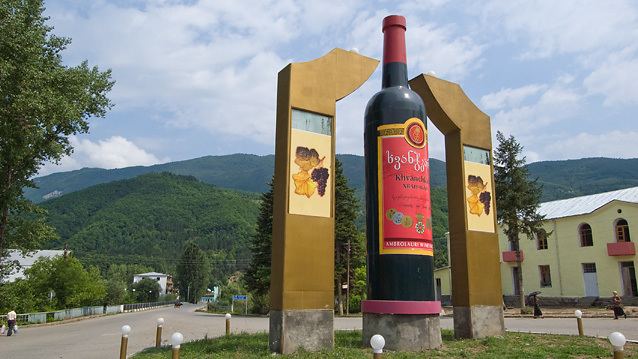Area code(s) +995 439 Area 160 ha Population 2,047 (2002) | Elevation 550 m (1,800 ft) Post code 0400 Website Ambrolauri City Hall Local time Tuesday 10:42 AM | |
 | ||
Weather 6°C, Wind N at 6 km/h, 62% Humidity | ||
Ambrolauri (Georgian: ამბროლაური) is a city in Georgia, located in the western part of the country, on both banks of the Rioni river, at the elevation of 550 m above sea level. It is a self-governing city. At the same time, the city serves as the seat of the Racha-Lechkhumi and Kvemo Svaneti regional administration and of the Ambrolauri Municipality. According to the 2014 census, the city had a population of 2,047. Its area is 1.6 km2.
Contents
Map of Ambrolauri, Georgia
Ambrolauri is first recorded in the 17th century as a place, where one of the palaces of the kings of Imereti was located. It acquired the city status in 1966 and became a self-governing city with its own municipal government in 2014.
History
The territory of Ambrolauri has not been systematically studied archaeologically. The toponym Ambrolauri is known from the 17th century. The Russian diplomat Alexey Yevlev, who visited the Kingdom of Imereti in 1650, and then the Georgian scholar Prince Vakhushti, writing c. 1745, mention a royal castle at Ambrolauri, where the Krikhula River becomes a tributary of the Rioni. Only insignificant ruins of that palace have survived. The name of the city may have been derived from the surname Amarolisdze, while the settlement could have earlier been known as Metekhara, a toponym recorded in the 11th-century charter to the Nikortsminda Cathedral.
In 1769, the Imeretian king Solomon I granted Ambrolauri to a prince from the Machabeli family, Zurab, an in-law of the Tsulukidze, one of the leading families in Racha. An old three-storey tower built of stone and lime, located in the city, is still known to the locals as the Machabeli Tower. Ruins of a stone hall church are also found nearby. An inscription from the church doorway makes mention of King George III of Imereti (r. 1605–1639) and his family. A hoard of hundreds of coins buried early in the 17th century, including those with Arabic inscription stuck at Tbilisi and those issued in the name of George II of Imereti (r. 1565–1585), was unearthed in 1909.
After the Russian conquest of Imereti in 1810, Ambrolauri became a part of the Racha district (uyezd). In Soviet Georgia, it became the seat of the Ambrolauri district (raion) in 1930 and acquired the city status in 1966. In 1934, Ambrolauri was renamed into Enukidze after the Soviet statesman Avel Yenukidze, on whose execution in 1937, the city's old name was restored. In 1968, Ambrolauri had a population of 4,400.
The city was damaged in the 1991 Racha earthquake. It, further, experienced a decline in population and economic activity in the years of post-Soviet crisis. Ambrolauri became the seat of Racha-Lechkhumi and Kvemo Svaneti regional administration in 1995. As a result of the local government reform in 2014, Ambrolauri was split from the homonymous municipality as a self-governing city and the city's population directly elected its first ever mayor.
Government
Ambrolauri is a self-governing city with its own municipal governance—a representative council (sakrebulo) and an executive body headed by a mayor. Like in Georgia's other self-governing territorial subdivisions, the city's population directly elects both the council and mayor for a four-year term. Ambrolauri is the seat of the State Commissioner (or governor), representing Georgia's central government in the city of Ambrolauri and four other municipalities grouped together into the Racha-Lechkhumi and Kvemo Svaneti region. Ambrolauri also houses the bodies of local self-government of the Ambrolauri Municipality, which is a separate self-governing community.
Culture
Ambrolauri is home to the Museum of Fine Arts, and a theatre. The environs of Ambrolauri are rich in historical monuments such as the churches of Barakoni and Nikortsminda. A recreational zone is being developed at Shaori Lake, south of Ambrolauri.
Transportation
Ambrolauri is served by an airport, opened in January 2017, which can serve small planes carrying 15–20 passengers. Its runaway is 1.1 km long and a terminal of 600 square meters can serve about 50 people at a time.
